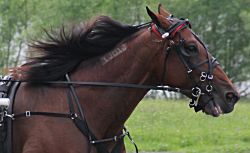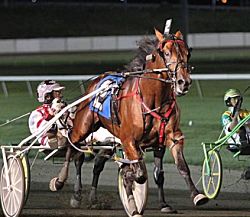Doo Wop Hanover defies the odds for 2017 debut
March 2, 2017,by Kim French, USTA Internet News Editor

Kim French
Columbus, OH — Eleven months ago it appeared his career, if not his life, may very well have been in jeopardy. However, Doo Wop Hanover has not only survived, but will pace from post position eight in his fourth qualifying race at The Meadowlands on Friday (March 3) in preparation for a campaign this year that truly is a return of divine proportions.
“I have never had a horse break a coffin bone in his hind leg,” said Peter Blood, the horse’s co-owner and winter conditioner. “They have always been in the front legs and those fractures are difficult enough to heal correctly for a horse to return to full performance, but he appears happy to be out there and doing his work.”
It is a profession in which the son of Rocknroll Hanover-Deer Valley Miss has excelled.

USTA/Ken Weingartner photo
Doo Wop Hanover has earned $761,729 with a resume of 47-13-6-6 and a lifetime mark of 1:47.4f.
Also owned by Rick Berks, Doo Wop Hanover has earned $761,729 with a resume of 47-13-6-6 and a lifetime mark of 1:47.4f. He defeated the likes of world champion State Treasurer, the $2.19 million man All Bets Off and 2014 Jug victor Limelight Beach in the $225,000 Jim Ewart Memorial in 2015. That campaign also saw Doo Wop Hanover sweep the Graduate Series on his way to $454,422 in season’s earnings.
The talent is obviously present; yet the reason this horse remains in competition is a testament to his own fortitude and the patience of his trainer, Steve Elliott, in addition to those who own him.
To date, he has appeared in three qualifying races at The Meadowlands in the month of February, finishing third behind Always At My Place and stablemate Rockeyed Optimist with a :27.4 final quarter-mile, fifth behind recent Dover Downs feature winner Take It Back Terry after spiking a fever and a strong third in arrears of All Bets Off and Odds On Equuleus, pacing his mile in 1:53.1.
Hall of Famer John Campbell, as usual, was holding the lines.
After a 2015 season where Doo Wop Hanover was one of the top pacers in the sport, he developed a condition that occurs in less than .005 percent of equines and resulted in his rare hind leg injury.
“He began mutilating himself,” said Blood, a New England, Florida and Plainridge Wall of Fame member. “It was one of the saddest things I have ever witnessed and I tried everything, including professionals, to look at him and see what we could do. He broke the coffin bone kicking in his stall, but it was a result of his episodes from this issue. We really did not know what we were going to have to do, not just with the coffin bone healing, but with him.”
Doo Wop Hanover suffered through what Blood refers to as a “mental illness” that may be related to the size of the horse’s testicles.
“They were like melons,” he said. “The veterinarian even said when he was gelded they were the largest he had ever seen.”
According to research published by the University of Pennsylvania’s School of Veterinary Medicine, the situation Doo Wop Hanover endured is not common, yet present and noted in many species, including humans.
“In extreme cases, the horse can violently lunge its body or head into a wall or other solid object. More rarely, a horse might “throw itself” to the ground (from standing to lateral recumbency),” the paper states. “A single episode can last from a few seconds to several minutes, uninterrupted. The horse can work up a lather and steam in cool weather. Episodes usually occur in a series separated by a few seconds to a few minutes over a period of minutes, to hours. The total daily time spent self-mutilating can vary from a few seconds to an hour or more. In addition to bite wounds, the most common injuries are to the legs and feet from the spinning and kicking.
“Self-mutilation behavior of one form or another has been described in many different species, including humans. Dogs and cats lick and chew on their paws or tails. People do all sorts of things — pull out their hair, bite their fingernails or lips, scratch themselves, or deliberately inflict burns, cuts, or other wounds.
“People who have seen a horse in the midst of attacking itself often describe the episodes as the most bizarre animal behavior they ever have seen. Mental health professionals or others with first-hand experience with human psychopathology often ask whether this might be the horse equivalent of severe neurotic or even truly psychotic behavior seen in people. For example, Dr. Nicholas Dodman, a veterinary animal behavior specialist at Tufts New England Veterinary College, said he has wondered whether certain forms of self-mutilation in horses might be similar to Tourette’s Syndrome in humans. There are some interesting similarities, and some clear differences.”

Lisa photo
Doo Wop Hanover swept the 2015 Graduate Series on his way to $454,422 in season’s earnings.
In Doo Wop Hanover’s case, Blood decided to geld him and then sent him to Rod Allen with a “wait-and-see” approach.
“I have all the faith in the world in Rod,” Blood said. “But even after gelding Doo Wop, we didn’t know if he would ever make it back. Rod took his time with him and continued to provide reports on his progress; after more than 50 years in this business I realized what his chances were of racing again.”
Castration may not have repaired all of Doo Wop Hanover’s symptoms, but it has certainly aided in sustaining his life and rejuvenating an attempt at his return to what he truly does enjoy — pacing.
“We staked him,” Blood said. “He will race prior, but his first stake is the Ben Franklin (eliminations on June 24) and he is eligible to the Dan Patch, the Jim Ewart, Dayton Pacing Derby, Allerage and Breeders Crown.
“What happened to him is something you never want to see and do not very often. I’d like people to know about Doo Wop in case it happens to them. I always talk to people to ask what they have experienced with their horses to use their knowledge and apply it.
“I remain cautious with expectations of him, but he has so much ability. We can only see what he will accomplish.”
